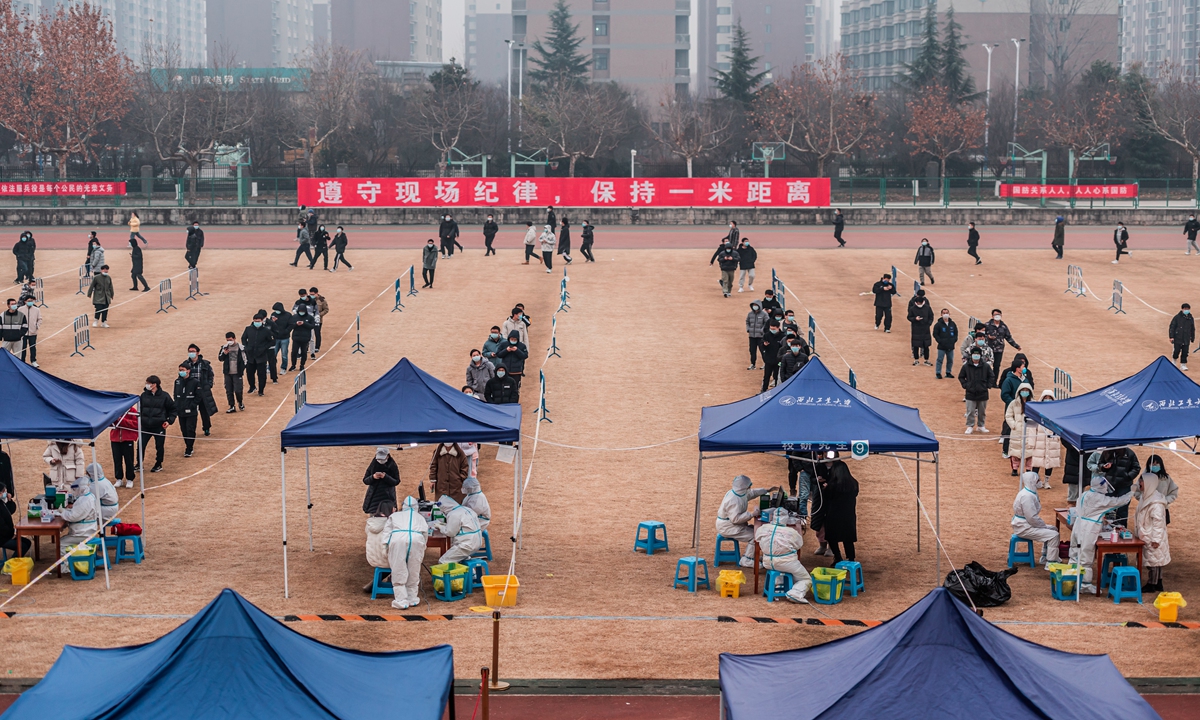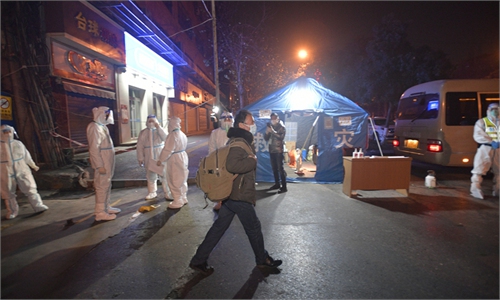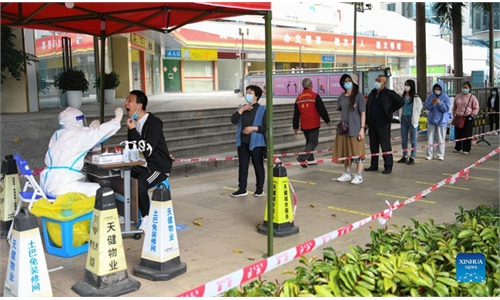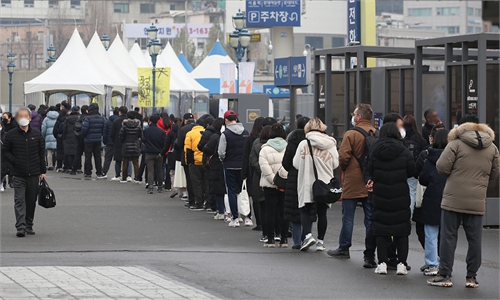Why did NYT fabricate contradiction between Chinese people and zero-COVID policy?

Residents line up to take a nucleic acid test on Tuesday in Xi'an, Northwest China's Shaanxi Province. Photo: VCG
The online edition of the New York Times published an article written by Alexandra Stevenson on January 6 about the new outbreak of COVID-19 in Xi'an, Northwest China's Shaanxi Province. The headline of the story reads "China's Latest Lockdown Shows Stubborn Resolve on Zero-Covid."One of the keywords is "stubborn". The dictionary explains it as having or showing an unyielding determination to refuse to change one's attitude or position on something, even if there are good arguments or reasons for doing so.
The narrative develops to confirm this theme. In particular, the author cites the inconveniences caused by the city's lockdown, such as the suspension of ordinary life and the difficulty in accessing medical services. The author also mentions that residents have received vegetables from the government. Then she changes her tune, "But by then, residents were already complaining online that officials were putting the pursuit of a zero-COVID policy ahead of the well-being of citizens."
As somebody who happened to be in Xi'an at the time, experiencing the events as they unfolded, I don't know why the author would intentionally pit the notions of a zero-COVID policy and the well-being of citizens against one another.
In the first few days, some residents were unable to get enough vegetables and went online to ask the government to solve the problem as soon as possible, but few people complained about the zero policy because they knew that it was for their own safety.
"To critics, the pain, suffering and confusion caused by the lockdown have made Beijing's virus strategy appear increasingly unsustainable," the author writes. I won't dwell on the facts that she has carefully selected to prove the failure of the zero-COVID policy.
At the end of the story, the American journalist quotes from an online article by a Xi'an writer named Jiang Xue. "The death of any individual is the death of all." This refers to an elderly man who failed to receive timely treatment due to epidemic control.
It looks like that the Xi'an people are living in a disaster caused by the zero-COVID policy, and behind it is "China's authoritarian style of leadership."
This story was sent to me by my Chinese friends in the US. Several of them have family in Xi'an and were worried about the living conditions of their families.
I told them that we are alive and well. None of the 13 million people in Xi'an have died because of COVID-19, and the vast majority of the people have enough vegetables, fruits and basic necessities. Problems such as difficulty of purchasing medicine and accessing medical care have been quickly resolved.
In this round of the epidemic, as of Tuesday, the number of deaths due to COVID-19 in Xi'an has remained at zero, and the number of confirmed positive cases has dropped to 13 (January 10), with cured people being discharged from hospitals every day.
One more word, in particular, is needed. The day after this New York Times story was published, a 4-day-old baby was diagnosed and immediately taken to the hospital for medical attention.
Of course, this reporter is not going to tell the whole story. She was following her own choice of where to draw focus.
During the city's lockdown, two patients and two pregnant women were not treated in a timely manner, and the incident received a great deal of attention from the public and government, and prompted a rapid adjustment in policy.
Human lives are at stake, and each individual life is a matter of heavenly importance, but the cases of these four Xi'an residents are not antithetical to the well-being of 13 million citiezens, or 1.4 billion Chinese people. If you truly care about the lives of Chinese people, then they should be seen as a whole. It should not be used to completely negate another policy designed to protect more lives.
The zero policy is dynamic, not "stubborn," and will minimize deaths through dynamic adjustments, and will ensure the lives of every ordinary citizen.
The public outcry over this incident is an indication of the importance Chinese people place on life and why the Chinese government must adhere to a dynamic zero-COVID policy.
What we are seeing now is that the local government has immediately adjusted to the actual situation - removing those who should be removed, fining those who should be fined, and changing regulations that need changing. This also provides a reference for the management and policy design of other cities in the next step of epidemic prevention.
These days, Xi'an residents stay at home and receive their nucleic acid testing on time and peacefully. Some districts were sealed and controlled, and some residents were moved and quarantined, all in a fairly orderly manner. I have witnessed the transfer and quarantine of one neighborhood as residents pulled luggage, held their children and got into buses in an orderly manner. The transfer occurred at mid-night, but there was hardly any noise. Thousands of healthcare workers, police and volunteers silently stayed on the front line.
They knew that the zero-COVID policy was the key to ensuring the lives of 13 million people.
A fatal problem with the NYT piece is that the author intentionally obscures the most important criterion for evaluating whether the epidemic prevention policy is correct, namely mortality rates.
So far this year, China has maintained a zero mortality rate for new cases, while the US averaged 1,664 deaths per day during last week. This is not to say that the US government doesn't want to reduce the death rate, but it can't, due to a different system.
I really doubt that this reporter has even the slightest, yes, even the slightest hint of humanitarian sentiment since she has avoided this statistic. Her concern was not for the safety of the lives of the Chinese people, but whether her reporting would show her "keen eye" for exposing the dark side of the Chinese system.
To this day, the New York Times is still writing about China in this old-fashioned, biased way. How stubborn! This stubbornness has reached the point of stupidity.
To borrow the last sentence of this article, what should be said about the death rate in the US if "the death of any individual is the death of all"?
The author is a senior editor with People's Daily, and currently a senior fellow with the Chongyang Institute for Financial Studies at Renmin University of China. dinggang@globaltimes.com.cn. Follow him on Twitter @dinggangchina




